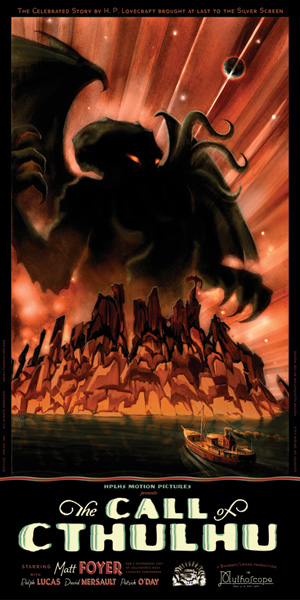Film Review ? Call of Cthulhu (2005)
 Get "The Call of Cthulhu" at Amazon.com
Get "The Call of Cthulhu" at Amazon.com
When I entered Middle School, I started reading the works of HP Lovecraft. If you’re a fan of Horror, especially horror in the vein of the fantastic, you probably know some of Lovecraft’s works, without actually reading them. Lovecraft has inspired many a horror writer and director, from John Carpenter (“In the Mouth of Madness”) to Steven King (“The Mist”). However, while homages to his work have been made off and on over time, direct adaptations of his work have generally sucked, and sucked hard.
I’ll be frank – Lovecraft’s work doesn’t lend itself to adaptation very well. As I’ve mentioned elsewhere, Lovecraft’s horror was derived from the idea that the human brain was incapable of realizing how insignificant humanity is in the vastness of space, and if we ever realized it, our minds would shatter – and they’d be even further destroyed if there were older, more powerful races than us, that thought in ways that we couldn’t possibly imagine. Now, putting aside the fact that humanity has recognized just how small we are in the universe, and not only has survived without mass hysteria, but had a response that could best be described as “apathy”, this type of horror just doesn’t film well. Far more often, Lovecraft had to try to convey this by having the cosmic terrors be something that words couldn’t describe, which is a bit of a cheat – though one that ages better. Still, this is something that doesn’t necessarily film as well either – and it’s something that, frankly, most directors haven’t tried to do.
Instead most directors have tried to go to the personal horror route. Perhaps the most adapted of all of Lovecraft’s stories is The Shadow Over Innsmouth, in which a reporter goes to the city of Innsmouth in New England to investigate, and discovers a great horror within the city. The barely escapes from the inhabitants, who have become less human and more something else. In his investigations from outside the city, he discovers a terrible shock to his identity, that he too carries some of the inhuman heritage of the residents of Innsmouth and returns. The idea with this adaptation is that the audience would be able to emphasize with this struggle over identity. This is not, however, Lovecraft’s most famous story, and the one which named his mythos.
The work that named his Cthulhu Mythos, and inspired the Role-Playing Game of the same name, is “The Call of Cthulhu”. Until the film I’m reviewing now, that story was never adapted. Near as I can tell, it’s due to needs of design, and the structure of the story’s narrative.
The film essentially consists of several stories, within a story, within a story. The narrator of the story is visiting his friend, Francis Wayland Thurston, at an insane asylum, presumably the Asylum in Arkham, Mass. Thurston thinks he is about to die and wants the narrator (a character added for the film), to destroy some documents in his possession. These documents relate to the investigation of the Cthulhu cult. Some of these documents were collected by Thurston’s great-uncle, some by Thurston himself. All of these stories connect to a climactic account of the brief rising of sunken R’yleth and its sinking once again, after terrorizing the crew the Emma, now commanding the Alert, a derelict they’d boarded after their own ship was badly damaged in a storm, and with the Alert being in better condition.
The film adaptation, done by the HP Lovecraft Historical Society (or HPLHS for short), basically dodges all the problems that would come with adapting this film using modern technology, by shooting it as a silent movie instead. The film is shot in black and white, with some added film grain to give the implication that the film stock had been sitting in a vault for 80 years. There is a score to the film, but no other sound. There is no spoken dialog, with insert cards conveying the dialog from the film. Any special effects are done in miniature, with a few done with stop-motion photography.
It works. It works splendidly. Because the film uses the style of a silent film and the trappings of a silent film, it becomes easier to suspend disbelief over any effects shortcomings in the film. We, the audience, don’t have to make a big deal about how Cthulhu is obviously a stop-motion puppet – it’s done in the style of film in the 1920s, of course it’s a puppet. This, in turn, allows the film to do its work. By the conclusion of the film, and the sequences surrounding the crew of the Alert, I actually found the film provoking a feeling of dread – the good kind, the kind a horror filmmaker wants. During this segment, people in the room watching it with me were silent. They laughed at some earlier segments of the film, scenes that were meant to have some camp to them, but here they were silent, and watching with intent. This segment in particular even gave my mother nightmares.
This is an excellent horror film, and a fitting tribute to the works of Howard Phillips Lovecraft. I give this movie a wholehearted recommendation.
Filed under: film, Reviews Tagged: Cthulhu Mythos, DVD, film, review




0 Comments
Recommended Comments
There are no comments to display.